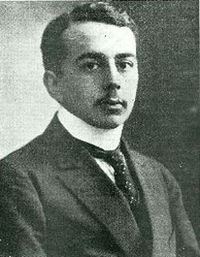Nationality Hungary Name Denes Konig Parents Gyula Konig | Doctoral students Tibor Gallai Role Mathematician Fields Mathematics | |
 | ||
Born September 21, 1884
Budapest, Austria-Hungary ( 1884-09-21 ) Institutions Technical University of Budapest Died October 19, 1944, Budapest, Hungary Alma mater Budapest University of Technology and Economics Doctoral advisor Jozsef Kurschak, Hermann Minkowski Similar People Jozsef Kurschak, Tibor Gallai, Hermann Minkowski | ||
Dénes Kőnig
Denes Konig (September 21, 1884 – October 19, 1944) was a Jewish Hungarian mathematician who worked in and wrote the first textbook on the field of graph theory.
Contents
Biography
Konig was born in Budapest, the son of mathematician Gyula Konig. In 1907, he received his doctorate at, and joined the faculty of the Technische Hochschule in Budapest (today Budapest University of Technology and Economics). His classes were visited by Paul Erdos, who, as a first year student, solved one of his problems. Konig became a full professor there in 1935. To honor his fathers' death in 1913, Konig and his brother Gyorgy created the Gyula Konig prize in 1918. This prize was meant to be an endowment for young mathematicians, however was later devaluated. But the prize remained as a medal of high scientific recognition. In 1899, he published his first work while still attending High School in a journal Matematikai es Fizikai Lapok. After his graduation in 1902, he won first place in a mathematical competition "Eotvos Lorand". Shortly after he wrote the first of two book collections Matematikai Mulatsagok (Mathematical Entertainments). He spent four semesters at the university in Budapest and his last five in Gottingen, during which he studied under the famous mathematicians Jozsef Kurschak and Hermann Minkowski. He then received his doctorate in 1907 due to his dissertation in geometry, that same year he began working for the Technische Hochschule in Budapest and remained a part of the faculty till his death in 1944. At first he started as an assistant in problem sessions, in 1910 he was promoted to "oberassistant", and then promoted to "Privatdocent" in 1911 teaching nomography, analysis situs (later to be known as topology), set theory, real numbers and functions, and graph theory (the name "graph theory" didn't appear in the university catalogue until 1927). During this time he would be a guest speaker giving mathematics lecture for architecture and chemistry students, in 1920 these lectures made their way into book form. at the Technische Hochschule.
From 1915 to 1942 he was on a committee to judge school contests in mathematics, collecting problems for these contests, and organizing them. Then in 1933 he was elected as secretary of the society and in 1942 he became the chairman of this committee. He then decided to make edits in the society's journal during his time on the committee till his death. Konig's activities and lectures played a vital role in the growth of graph theoretical work of: Laszlo Egyed, Pal Erdos, Tibor Gallai, Gyorgy Hajos, Jozsef Kraus, Tibor Szele, Pal Turan, Endre Vazsonyi, and many others. He then went on to write the first book on graph theory Theorie der endlichen und unendlichen Graphen in 1936. This marked the beginning of graph theory as its own branch of mathematics. Then in 1958, Claude Berge wrote the second book on graph theory, Theorie des Graphes et ses applications, following Konig. After the occupation of Hungary by the Nazis, fortunately for persecuted mathematicians he worked to help them.
On October 15, 1944 the National Socialist Arrow Cross Party took over the country. Days later on October 19, 1944 he committed suicide to evade persecution from the Nazis being a Hungarian Jew.
